A research team led by Wu Haiyan, assistant professor at the Centre for Cognitive and Brain Sciences of the University of Macau (UM), has achieved significant advances in the field of oxytocin and social cognitive neuroscience. Their research provides new evidence and a corresponding mechanism on how oxytocin causes increased associations among inter-individual differences, and also provides inspirations for future research on the clinical and non-clinical applications of oxytocin. The research results have been accepted by several internationally renowned journals, such as Human Brain Mapping.
Oxytocin, an important neuropeptide, has been proven to be closely linked to social adaptation, pro-social behaviours, and social cognition. At the behavioural level, oxytocin can modulate human abilities in recognising and memorising social cues such as faces and emotions. Specifically, some researchers have found that oxytocin can boost recognition memory for faces and increase amygdala responses to emotional faces. In addition, previous studies have shown that oxytocin can promote social bonding, navigate social interactions, and regulate the processing of salient information.
Self-other distinction plays a crucial role in daily social interactions and decision-making. Moreover, faces serve as the most salient stimuli in making social decisions that involve oneself or others. People adjust their altruistic behaviours and corresponding economic decisions according to the similarity between their faces and those of others.
The research team investigated the effects of oxytocin on the relationship between individuals’ functional connectivity and behaviour. They found that oxytocin significantly enhances the links between resting-state functional connectivity, task-state functional connectivity, and task behaviour performance. Subsequent analysis further revealed that the enhancement in these connections can be explained in part by the fact that oxytocin alters the functional connectivity of the brain in both resting and task states, mainly involving areas such as the limbic system, the prefrontal cortex, the temporal pole, and the temporoparietal junction.
The study employed a connectome-based predictive model (CPM) to examine whether functional connectivity in different states can predict task behaviour performance, and whether oxytocin can improve the prediction accuracy of functional connectivity in behavioural performance. A correlation analysis was conducted at the whole-brain level to assess the correlation between resting-state and task-state functional connectivity, and evaluate the effect of oxytocin on the relationship between functional connectivity in the two states. CPM can predict cognitive behaviour or personality traits on the basis of functional connectivity and has been widely used in brain-wide association studies (BWAS). It is often used to extract the most relevant features from functional connectivity in order to predict individual variability in behaviour, personality traits, or psychiatric symptoms. Many previous studies have demonstrated the robustness of CPM in predicting individual differences in fluid intelligence, attention, creativity, and cheating behaviours.
The study found that the group administered with oxytocin demonstrated significantly higher predictive accuracy in CPM compared to those administered with a placebo, in both resting and task states. Furthermore, the correlation between resting-state and task-state functional connectivity was notably stronger in the oxytocin group compared to the placebo group. Additional findings indicated that the CPM classifier could significantly distinguish the functional connectivity between oxytocin and placebo groups in both task and resting states. In the oxytocin group, most of the functional connections with larger weights in the CPM classifier were significantly correlated with behavioural performance, an effect not observed in the placebo group. These findings provide new evidence and a corresponding mechanism for how neuropeptides contribute to increased associations among inter-individual differences across different levels. They may inspire future interdisciplinary research on the clinical and non-clinical applications of neuropeptides.
Zhang Haoming and Chen Kun, PhD students at UM’s Centre for Cognitive and Brain Sciences are the co-first authors of the study. Bao Jin, a researcher at the Shenzhen Institute of Advanced Technology under the Chinese Academy of Sciences, also contributed to the study. The research project was supported by the Science and Technology Development Fund of the Macao SAR (File no: 0127/2020/A3 and 0041/2022/A), the Natural Science Foundation of Guangdong Province (File no: 2021A1515012509), the Shenzhen-Hong Kong-Macao Science and Technology Innovation Project (Category C) (File no: SGDX2020110309280100), and UM (File no: SRG2020-00027-ICI and MYRG2022-00188-ICI). The full version of the research article can be viewed at https://doi.org/10.1002/hbm.26498.
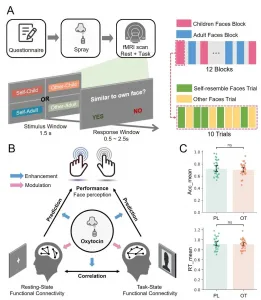
The main structure of the study
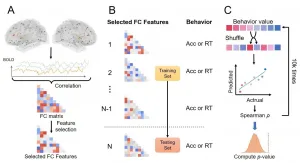
The predictive model based on functional connectivity (FC)
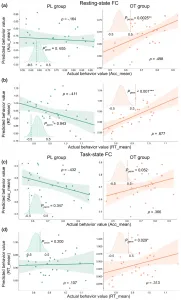
The results of using CPM to predict task performance by resting-state FC and task-state FC
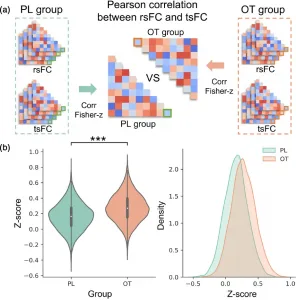
The correlation between resting-state FC and task-state FC in two groups of subjects
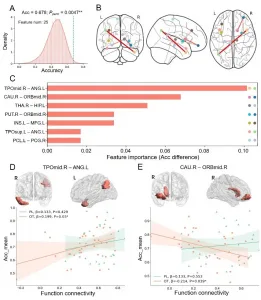
The results of the CPM classifier in the classification of resting-state FC
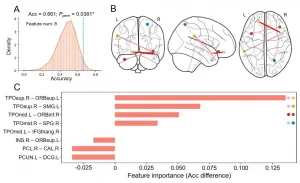
The results of the CPM classifier in the classification of task-state FC


